Contents
Market Overview
Macro Review
U.S. regional bank woes continue but strength in NFP creates more challenges for Chair Powell. Regional banks sold off just after the FOMC press conference, where Powell had said that conditions in the banking sector had broadly improved since March. The stock market disagreed. Jamie Dimon reiterated that he did not see a banking crisis unfolding, although that was after JPM had acquired First Republic Bank for $10.6 billion, which also saw the FDIC agreeing to $50 billion as a 5-year fixed-rate term facility aimed at plugging the gap in lost deposits. The transaction ultimately allowed JPM to book a one-time gain of $2.6 billion, courtesy of the $13 billion loss directly to the FDIC. The next headache was around PacWest, which came as little surprise given it was down 77% since the beginning of March. Western Alliance was rumored to be looking at strategic options, just as Toronto Dominion called off its acquisition of First Horizon and paid a $200 million penalty for doing so. Markets appeared calm but the VIX did begin to break noticeably above 20pts on Thursday. U.S. Treasury yields also fell as interest rate cuts were priced in over the summer, although this was partially reversed as unemployment fell to 3.4% on Friday. The next brewing crisis is over the debt ceiling where Treasury Secretary Yellen suggested the “X date” was early June, whereas the market had previously been working under the assumption that it was in late July. This caused T-Bill yields to sharply rise and the latest auction pushed yields to 5.84%, the highest level since 2000. The opposite is true for the ECB, who instead are focusing on inflation with “more ground to cover” in terms of tightening policy. Lagarde was explicit in stating that the ECB are “not pausing, that is extremely clear” but did cede that policy was in “restrictive territory”. Separately, crude oil was under pressure on recessionary risks and lower gasoline demand in the U.S., with the commodity down over 5-6% over the past week. Within EM, China’s contraction in the Caixin Manufacturing PMI highlights an uneven recovery and led to 5-year NDIRS rallying to a YTD low of 2.70%. Brazil held policy rates unchanged at 13.75% with a possible cut penciled in for September. A similar theme is developing in Central and Eastern Europe as Hungary had tweaked policy and the Czech Republic held policy rates unchanged. The second theme after monetary policy was with the IMF. Argentina gained U.S. support for early disbursement of $10.6 billion, Kenya received $300 million and Tunisia is ever closer to securing a program. Needless to say, Pakistan remains in an information vacuum without any IMF developments, which had been expected after recent comments from the Minister of Finance.
EM Credit Update
Emerging market sovereign credit (cash bonds) ended the week up 0.1% with spreads 10bps wider. Sovereign outperformers were Tunisia, Argentina and Suriname, while Zambia, Pakistan and Ethiopia underperformed. It was a quiet week for EM aside from weakness in Chinese property and broader macro risks. Suriname also reached an agreement with key creditors to restructure $675 million of defaulted debt into a $650 million 7.95% 2033 bond and $275 million 2050 value recovery instrument that is linked to oil royalties. This creates an interesting restructuring solution for other defaulted sovereigns with emerging markets.
The Week Ahead
The Bank of England is expected to follow the Fed, ECB and Norges with a 25bps hike next week. Most of EM is holding interest rates unchanged as they are much further ahead of DM central banks. It is likely that the National Bank of Poland and National Bank of Romania hold rates unchanged at 6.75% and 7.0%, respectively. Meanwhile, China’s credit growth, trade and inflation data is due out next week. The recovery profile is expected to be weak with slow credit expansion, soft inflation and some fragility in exports. A softer inflation picture is expected out of the U.S. too. Key CEE inflation releases are due out of Hungary, with consensus pointing to 23%, followed by Czech Republic and Romania, which could move asset markets. We can expect Turkey’s current account release, where the deficit is expected to narrow. However, more emphasis will be on Turkey’s final, impartial poll from Konda on May 11. Finally, after an impressive PMI reading out of India, industrial production is expected to fall markedly from 5.6% in February to 3.6% in March.
Highlights from emerging markets discussed below:
Brazil’s Central Bank holds rates at 13.75%, confirms bias towards not easing monetary policy too soon, Paraguay’s general election delivered a market friendly result and Suriname reaches an agreement in principle with bondholders on sovereign debt restructuring.
Fixed Income
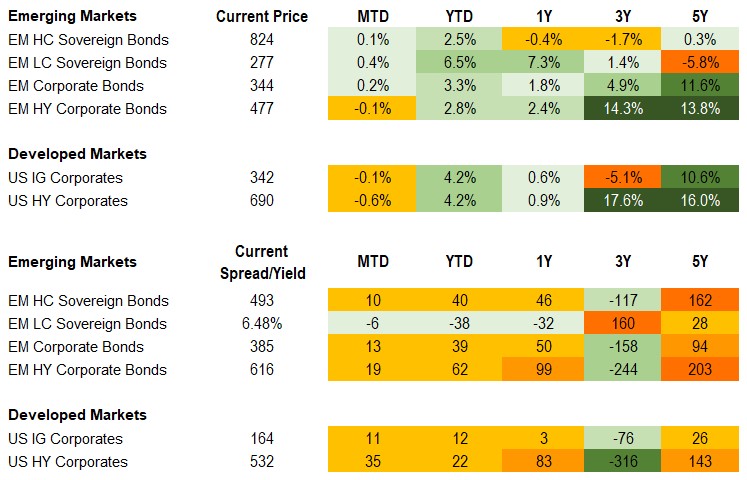
Equities
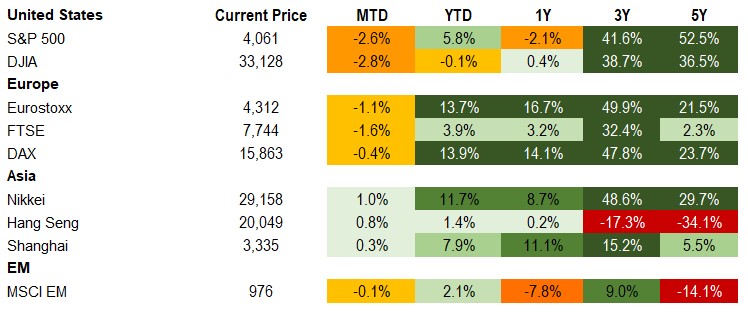
Commodities

Source for data tables: Bloomberg, JPMorgan, Gramercy. EM Fixed Income is represented by the following JPMorgan Indicies: EMBI Global, GBI-EM Global Diversified, CEMBI Broad Diversified and CEMBI Broad High Yield. DM Fixed Income is represented by the JPMorgan JULI Total Return Index and Domestic High Yield Index. Fixed Income, Equity and Commodity data is as of May 5, 2023 (mid-afternoon).
Emerging Markets Weekly Highlights
Brazil’s Central Bank holds rates at 13.75%, confirms bias towards not easing monetary policy too soon
Event: The Central Bank of Brazil (BCB) held its target policy rate (SELIC) at 13.75% and issued a post-meeting statement that retained a hawkish bias.
Gramercy commentary: With current annual (YoY) inflation having come down to 4.65% in March from a peak of 12% in April 2022, Brazil’s real ex-post policy interest rate of more than 9% is the highest among major emerging markets. Amid sharp focus on promoting economic growth and improving social equality by the Lula Administration, the BCB’s hawkish stance has generated significant backlash by the government, including by President Lula himself. There are concerns among the local business community as well about the increasing inability for many companies and households to refinance debt obligations. Nevertheless, the BCB has been abundantly clear that their focus is to bring down medium-term inflation expectations that the COPOM believes remains “unanchored” at 6.35% for September 2023, which is still significantly above the 3% target. In this context, we do not expect the BCB to start easing policy until 4Q at the earliest, which suggests that the BRL will likely continue to benefit from the highest carry among major EM currencies. The BCB’s policies enjoy the support of a centrist Congress that has helped it withstand political pressure thus far. However, it is likely that pressure by the Lula Administration increases further as economic activity deceleration becomes more meaningful in the second half of the year, especially if President Lula’s approval ratings take a plunge amid a slowing economy.
Paraguay’s general election delivered a market friendly result
Event: Santiago Peña, candidate of the ruling right-wing Colorado party, secured the presidency last weekend with 43% of votes and by a roughly 15% point margin to runner-up opposition candidate, Efrain Alegre. The outsider anti-system candidate, Payo Cubas, came in third with 23% of support. The Colorado party secured majorities in both chambers and governors in 15 of the 17 districts. Bonds outperformed on the back of the election results.
Gramercy commentary: We see the greater than anticipated victory by the ruling party as constructive and supportive of policy continuity and commitment to the reform agenda encompassed in the Policy Coordination Instrument agreement with the IMF. This, in conjunction with more supportive weather conditions helping to bolster improvement in economic and credit metrics relative to last year, should continue to buoy asset prices, all else equal. Important watchpoints on the fiscal agenda will include pension reform and expansion of the tax base in order to converge the deficit to the 1.5% of GDP ceiling under the fiscal responsibility law. Over the medium to long-term, deepening divisions within the ruling party in the context of growing support for anti-establishment candidates could give rise to uncertainty.
Suriname reaches an agreement in principle with bondholders on sovereign debt restructuring
Event: The government and its private creditors committee announced this week that they have reached an agreement on the key terms of restructuring Suriname’s 2023 and 2026 sovereign bonds. A new post-restructuring instrument will have a $650 million face value, 2033 maturity and 7.95% coupon, but the actual exit yield after the deal remains unclear. The agreement also includes a value recovery instrument (VRI) that can enhance investor recoveries in the event Suriname’s economy benefits more than currently expected from future oil revenues. The authorities have committed to pay 30% of its potential royalty income from the large Block 58 offshore field when/if commercial exploitation begins.
Gramercy commentary: The combined face value of Suriname’s two existing Eurobonds that are being restructured is $675 million. Accordingly, nominal debt reduction for the sovereign from the proposed transaction would be relatively limited. Liquidity relief appears to be more meaningful given the decrease in the coupon rate to 7.95% from 9.875% and 9.25%, respectively, for the existing securities but is relatively high in the context of other recent sovereign restructurings. What is different in the case of Suriname compared to most distressed EM sovereigns are prospects that the size of its tiny economy ($3 billion nominal GDP) could increase materially over the medium-term once projected offshore oil revenues become a reality. This should drive currently unfavorable sovereign credit metrics into much more benign territory even without material debt relief and lends itself nicely to the use of conditional VRIs. As such, Suriname’s resolution is rather idiosyncratic and unlikely to become a useful precedent for other ongoing or potential sovereign debt distress situations, in our view.
Emerging Markets Technicals
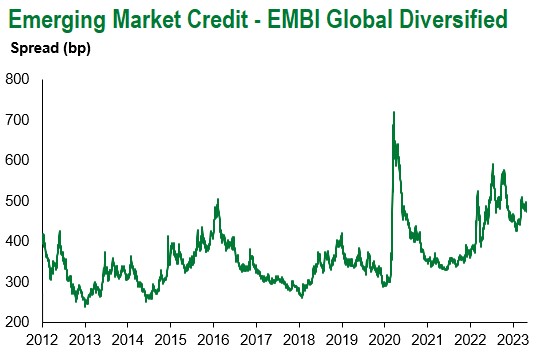
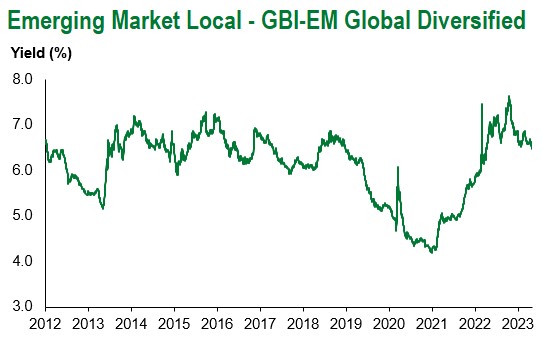
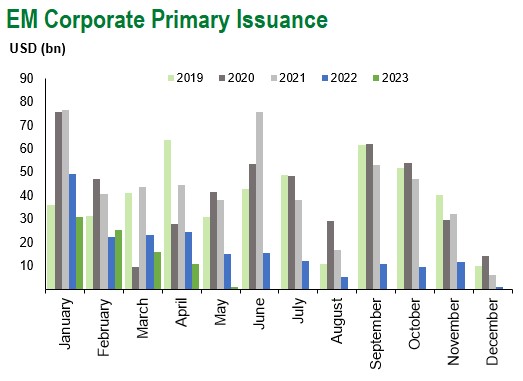
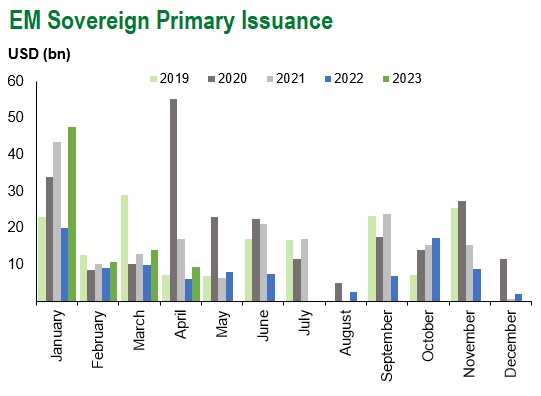
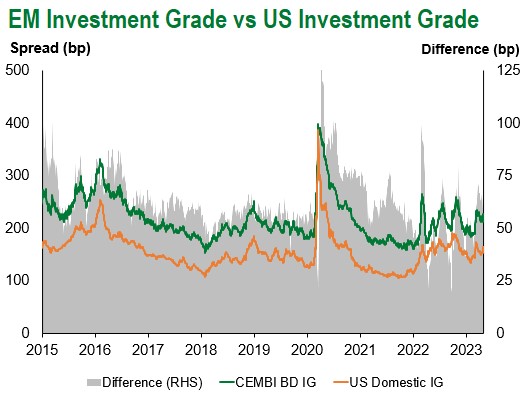
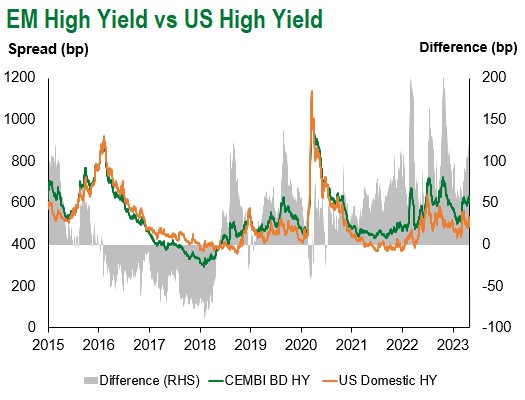
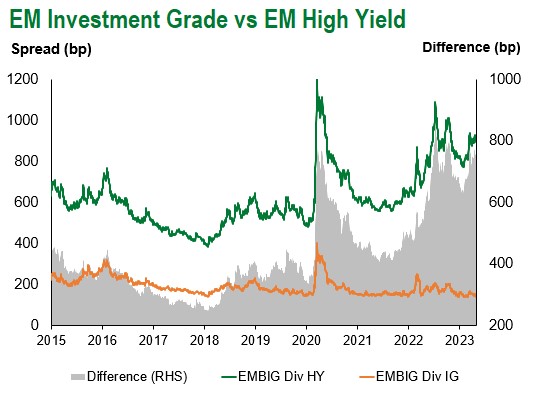
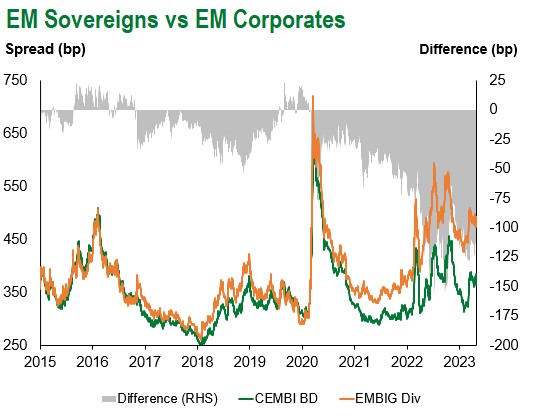
Emerging Markets Flows
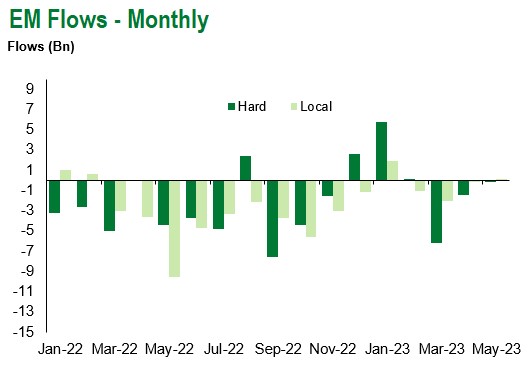
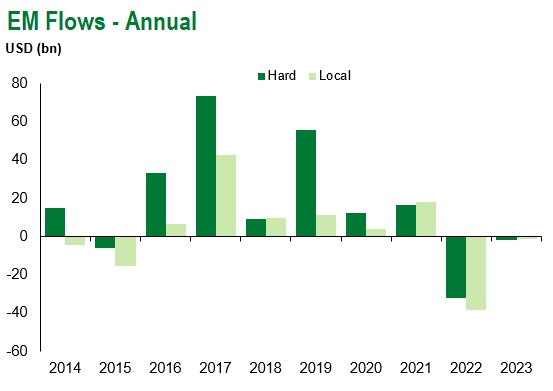
Source for graphs: Bloomberg, JPMorgan, Gramercy. As of May 5, 2023.
For questions, please contact:
Kathryn Exum, CFA ESG, Director, Co-Head of Sovereign Research, [email protected]
Petar Atanasov, Director, Co-Head of Sovereign Research, [email protected]
James Barry, Director, Deputy Portfolio Manager, [email protected]
This document is for informational purposes only. The information presented is not intended to be relied upon as a forecast, research or investment advice, and is not a recommendation, offer or solicitation to buy or sell any securities or to adopt any investment strategy. Gramercy may have current investment positions in the securities or sovereigns mentioned above. The information and opinions contained in this paper are as of the date of initial publication, derived from proprietary and nonproprietary sources deemed by Gramercy to be reliable, are not necessarily all-inclusive and are not guaranteed as to accuracy. This paper may contain “forward-looking” information that is not purely historical in nature. Such information may include, among other things, projections and forecasts. There is no guarantee that any forecasts made will come to pass. Reliance upon information in this paper is at the sole discretion of the reader. You should not rely on this presentation as the basis upon which to make an investment decision. Investment involves risk. There can be no assurance that investment objectives will be achieved. Investors must be prepared to bear the risk of a total loss of their investment. These risks are often heightened for investments in emerging/developing markets or smaller capital markets. International investing involves risks, including risks related to foreign currency, limited liquidity, less government regulation, and the possibility of substantial volatility due to adverse political, economic or other developments. References to any indices are for informational and general comparative purposes only. The performance data of various indices mentioned in this update are updated and released on a periodic basis before finalization. The performance data of various indices presented herein was current as of the date of the presentation. Please refer to data returns of the separate indices if you desire additional or updated information. Indices are unmanaged, and their performance results do not reflect the impact of fees, expenses, or taxes that may be incurred through an investment with Gramercy. Returns for indices assume dividend reinvestment. An investment cannot be made directly in an index. Accordingly, comparing results shown to those of such indices may be of limited use. The information provided herein is neither tax nor legal advice. Investors should speak to their tax professional for specific information regarding their tax situation.
